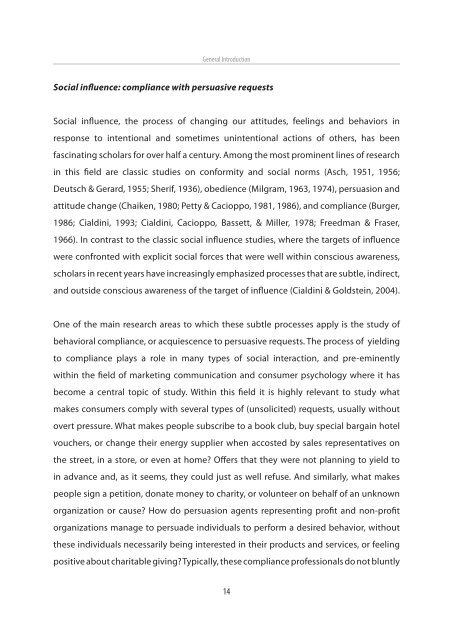Chapter 1 - Universiteit Twente
Chapter 1 - Universiteit Twente
Chapter 1 - Universiteit Twente
You also want an ePaper? Increase the reach of your titles
YUMPU automatically turns print PDFs into web optimized ePapers that Google loves.
General Introduction<br />
Social influence: compliance with persuasive requests<br />
Social influence, the process of changing our attitudes, feelings and behaviors in<br />
response to intentional and sometimes unintentional actions of others, has been<br />
fascinating scholars for over half a century. Among the most prominent lines of research<br />
in this field are classic studies on conformity and social norms (Asch, 1951, 1956;<br />
Deutsch & Gerard, 1955; Sherif, 1936), obedience (Milgram, 1963, 1974), persuasion and<br />
attitude change (Chaiken, 1980; Petty & Cacioppo, 1981, 1986), and compliance (Burger,<br />
1986; Cialdini, 1993; Cialdini, Cacioppo, Bassett, & Miller, 1978; Freedman & Fraser,<br />
1966). In contrast to the classic social influence studies, where the targets of influence<br />
were confronted with explicit social forces that were well within conscious awareness,<br />
scholars in recent years have increasingly emphasized processes that are subtle, indirect,<br />
and outside conscious awareness of the target of influence (Cialdini & Goldstein, 2004).<br />
One of the main research areas to which these subtle processes apply is the study of<br />
behavioral compliance, or acquiescence to persuasive requests. The process of yielding<br />
to compliance plays a role in many types of social interaction, and pre-eminently<br />
within the field of marketing communication and consumer psychology where it has<br />
become a central topic of study. Within this field it is highly relevant to study what<br />
makes consumers comply with several types of (unsolicited) requests, usually without<br />
overt pressure. What makes people subscribe to a book club, buy special bargain hotel<br />
vouchers, or change their energy supplier when accosted by sales representatives on<br />
the street, in a store, or even at home? Offers that they were not planning to yield to<br />
in advance and, as it seems, they could just as well refuse. And similarly, what makes<br />
people sign a petition, donate money to charity, or volunteer on behalf of an unknown<br />
organization or cause? How do persuasion agents representing profit and non-profit<br />
organizations manage to persuade individuals to perform a desired behavior, without<br />
these individuals necessarily being interested in their products and services, or feeling<br />
positive about charitable giving? Typically, these compliance professionals do not bluntly<br />
14
















